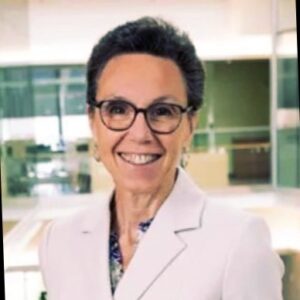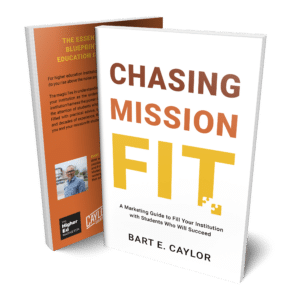Authentic Engagement: AI-Driven Chatbots for Higher Education
Explore how AI-driven chatbots enhance authentic student engagement without losing your human touch.
Branding
Student-centered learning is becoming increasingly important as students and families prioritize the return on investment in higher education.
Now more than ever, students and families are shifting their focus toward the real-world value they are getting out of their higher education experience.
With prospective students shifting their focus, higher ed marketers need to be flexible to keep up with changing times.
As prospective students focus more on outcomes, education brands have to adapt to show them how their educational experience can deliver the desired outcomes.
Being student-centered also entails respecting students’ time (or lack thereof!) and being willing to accommodate their complex schedules and life experiences.
Crafting strategies like this requires effort, but it is essential for success.

In this episode of The Higher Ed Marketer podcast, Anne shares why higher ed needs to tailor educational opportunities to a student-centered approach and meet students where they are.
Right away in this episode, we learned that USG is not just another educational institution.
As a regional higher education center within the University System of Maryland, The Universities of Shady Grove hosts nine university partners offering over 80degree programs in one convenient location in Montgomery County.
This collaborative model allows students to earn degrees from renowned institutions like the University of Maryland and Bowie State University while benefiting from the resources and support available at USG.
While most institutions claim to focus on student success, many still operate in a manner that prioritizes institutional needs over those of the students.
Anne Khademian and her team, however, are flipping this script by creating educational journeys that are tailored to the unique needs and circumstances of each student.
We’re all in the education business because we believe in students, and we want students to succeed. There’s no doubt about that.
But a lot of times the things that we do are more institutionally focused. Sometimes the things we do are about keeping institutional processes intact or in place.
Many times, we ask students to navigate a lot of complexity, and we invest in helping students navigate a lot of institutional complexity.
So at Shady Grove, we are deeply invested in this idea of centering the student in what we do.
Anne uses the analogy of online shopping versus traditional mall shopping to describe how education can evolve.
Just as online shopping platforms learn and adapt to individual preferences, Anne wants to meet students where they are, providing a seamless and customized educational experience.
This approach not only supports students academically but also considers their life responsibilities, such as work and family obligations.
In our conversation, Anne emphasized the need for institutions to pivot from traditional, institution-centered models to more flexible, student-centered approaches.
Higher ed marketers work in an environment where the “traditional student” model—living on campus, fully immersed in campus life, and eventually giving back as alumni—has long dominated, there’s a growing realization that this model doesn’t fit everyone anymore.
Anne rightly points out that while these deep traditions in academia are “beautiful and really powerful,” they also require a shift in thinking to better serve today’s diverse student population.
One effective way to do that is to laser-focus on the student’s return on investment.
So, reaching students in a different way, it’s a different opportunity to emphasize the quality, to emphasize the return on investment for [students].
One of the ways you honor the student experience is to focus like crazy on their return on investment. You think about their time and the quality of their time as well.
[Too often], we don’t respect students’ time. “Sorry, that class isn’t available for another year or so. You’re going to have to wait.” Or, “Sorry, those credits don’t transfer. I know someone told you that before, but sorry, they don’t transfer them now.”
This is not student-centered learning! This is totally institution centered.
[We should be] focusing in our communications and our work going forward on the return on investment for students.
It’s about meeting them where they are, respecting their time and their investment in what’s happening.
[It’s about] ensuring that [although] we can’t guarantee jobs by any sense, we can certainly try to line students up as best as we possibly can for great opportunities afterwards.
And we’re not just focused on a job. We’re focused on careers! We’re focused on lifelong learning.
Really communicating the return on investment for students [is key].
Going further, Anne critiqued the traditional notion of ROI which often equates success with getting into a top-ranked school.
This way of thinking is being increasingly questioned by students who are facing “huge, tremendous amounts of debt” and uncertain job prospects.
At The Universities at Shady Grove, Anne is spearheading efforts to ensure that students graduate with not just a degree but with the tools and connections they need for long-term success.
Their commitment to making students “career ready,” ensuring they have access to experiential learning, and striving for debt-free graduation are all part of a holistic strategy that meets students where they are.
“We’re going to connect you like crazy to employers and to opportunities so that you have some good choices when you graduate,” Anne explains, encapsulating a philosophy that puts student outcomes first, not just during their time at the university but throughout their careers.
This forward-thinking approach is a model for how institutions can adapt to better serve the evolving needs of their students.
One of the standout initiatives at USG is the development of industry sector hubs.
These hubs are designed to foster collaboration between academia and industry, ensuring that educational practices align with workforce demands.
By involving employers directly in the educational process, USG is creating a feedback loop that benefits students, academic partners, and industry leaders alike.
This is a huge challenge!
For so long, employers [have been] saying, “What’s going on? We need more talent! Why can’t you turn it out fast enough?”
And academic institutions are saying “It’s a process!” and “Providing a workforce is not our entire mission.”
We’ve been thinking a lot about how do we approach this, how do we build this deeper collaboration [between academia and industry].
Learning [needs] to happen on both sides. So, we’re approaching that in a couple of ways.
The main way we’re doing it is that we’re setting up industry sector hubs. The hubs are the USG team coming together with our academic partners in that particular industry sector and employers in that particular industry sector, up to 15 employers.
Throughout the year, employers and academic partners in the USG team – and four students on each hub as well – share ideas, look at the data, make plans for the pathway.
It’s a mutual learning process.
And then the same [goes for how] we create internships. [In these talks], employers are learning what the students need, what it’s going to be like, what their values are like.
Through these series of conversations, students are learning about what it means to be fully employed, and academic partners are learning as well.
This collaborative approach is particularly important as we approach the enrollment cliff and face the rapid advancements in technology, including generative AI.
Anne stresses the importance of flexibility and innovation, both in educational practices and in how institutions interact with industry partners.
Anne’s leadership at USG exemplifies how higher education institutions can adapt to the changing needs of students and the workforce.
By focusing on student-centered learning and fostering industry collaborations, USG is setting a new standard for what higher education can be.
Listen to our full interview with Anne Khademian to get even more insights into:
At Caylor Solutions, we are committed to helping higher ed marketers like you find, reach, and cultivate mission-fit students for your school.
Creating a student-centered learning environment and messaging strategy is crucial to being able to identify and attract more of the right students for your institution.
By leveraging our marketing audit services, you can dive deep into how your current messaging and content marketing strategy is performing so that you can strengthen it to be a truly student-centered learning approach.
If you’re concerned about how you can know that your marketing messages are getting the job done, you’ll love the peace of mind you’ll get with our customized, exhaustive marketing audit report.
At the end, we’ll give you an assessment of your digital presence, content effectiveness, and competitive positioning, concluding with a set of detailed, actionable recommendations to enhance marketing effectiveness and drive enrollment growth.
With Caylor Solutions’ marketing audit, you’ll know exactly where you are—and you’ll know the best way forward for greater marketing success!
Contact us today for more details.
The essential marketing book every higher education institution needs! If you are a higher education marketing professional seeking a fail-safe plan to make your institution stand out, “Chasing Mission Fit” is your guide.

So you can empower your institution with audience-focused marketing strategies, and attract mission-fit students who will flourish in your unique academic environment.
Ready to transform your institution’s marketing approach?
Order now!
Featured image via shadygrove.umd.edu
Subscribe to The Higher Ed Marketer podcast today!